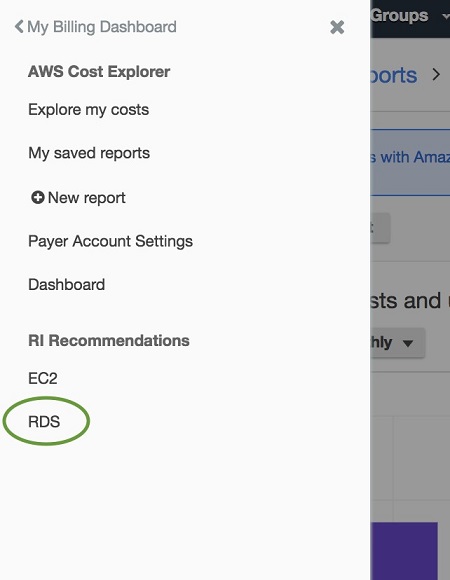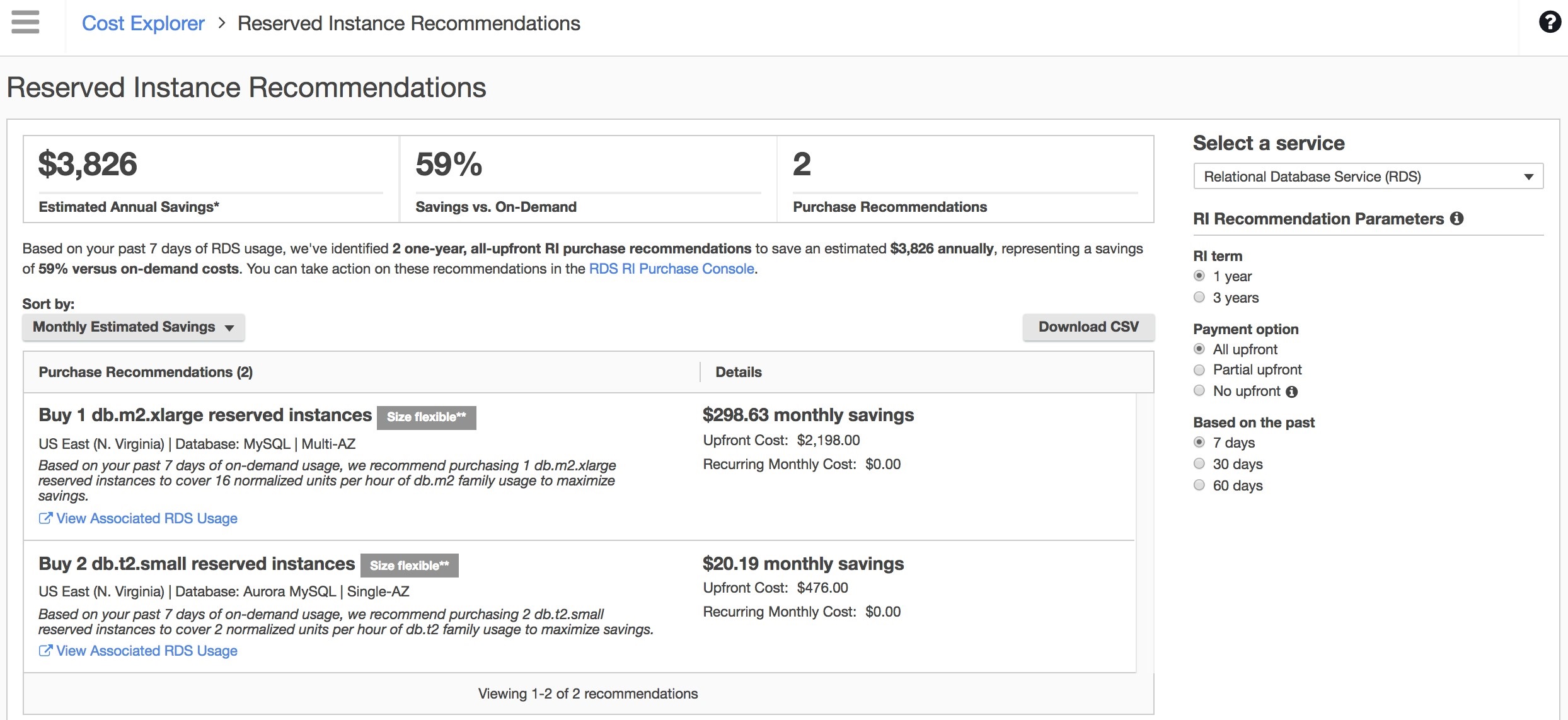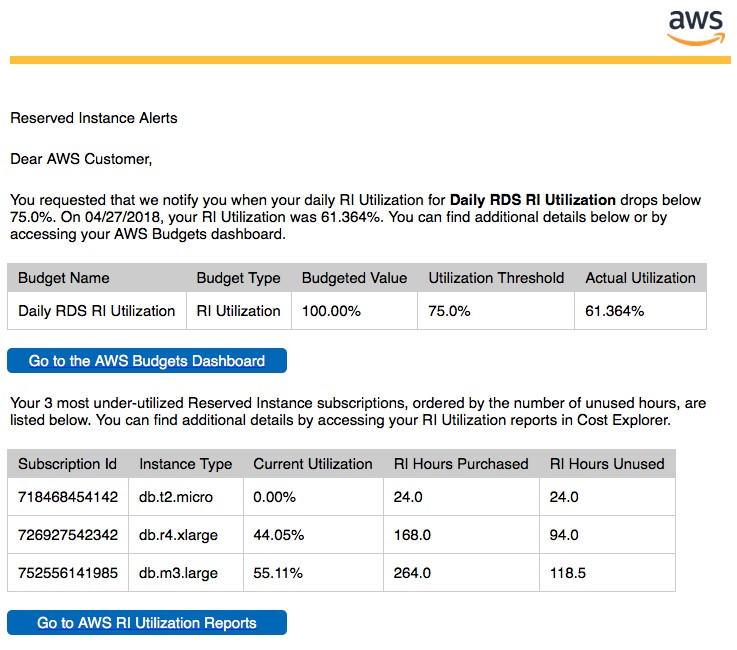AWS Database Blog
Using AWS Cost Management products to help save costs on Amazon RDS Reserved Instances
Using Amazon RDS, you can quickly and easily set up, operate, and scale your relational databases in the cloud. Amazon RDS Reserved Instances (RIs) give you the option to reserve a database instance for a one- or three- year term. This option can translate into significant discounts (up to 69%) compared to On-Demand prices.
In this post, you can learn how to use AWS Cost Management products to help you identify opportunities for cost savings using RIs. At the same time, you can use native AWS tooling to help manage your new and existing Amazon RDS RIs.
Using AWS Cost Explorer, you can visualize, understand, and manage your AWS cost and usage. You might already know that Cost Explorer is the best place to get started with your cost and usage analyses. But did you know that Cost Explorer also provides RI purchase recommendations based on your historical Amazon RDS usage? Using the navigation menu in the upper left-hand corner of Cost Explorer, you can quickly select RDS from the Recommendations area and access your customized RI purchase recommendations.
Getting started with Cost Explorer’s RI purchase recommendations for Amazon RDS
In the following screenshot, you can see the Cost Explorer console. 
 From the payer (master) account, you can access the RI purchase opportunities that Cost Explorer has identified for you. You do so by using Cost Explorer’s RDS RI Recommendations console. Cost Explorer automatically evaluates your historical Amazon RDS usage, then identifies all usage charged at On Demand prices. Cost Explorer then algorithmically simulates adding RIs to find the optimal mix of RIs to yield the most savings for your organization.
From the payer (master) account, you can access the RI purchase opportunities that Cost Explorer has identified for you. You do so by using Cost Explorer’s RDS RI Recommendations console. Cost Explorer automatically evaluates your historical Amazon RDS usage, then identifies all usage charged at On Demand prices. Cost Explorer then algorithmically simulates adding RIs to find the optimal mix of RIs to yield the most savings for your organization. You can also customize your RI purchase recommendations based on which type of RIs you want to purchase. For example, you can select a 1-year term and all upfront RIs and elect to base your recommendations on the past 30 days of historical usage.
You can also customize your RI purchase recommendations based on which type of RIs you want to purchase. For example, you can select a 1-year term and all upfront RIs and elect to base your recommendations on the past 30 days of historical usage.
You can then choose the View Associated RDS Usage link to quickly see what underlying On Demand RDS usage the recommendation is based on. In the example following, I clicked this link in my db.m2.xlarge recommendation to quickly look at the past 30 days of db.m2.xlarge usage in US East (N. Virginia). I can see that there are 24 hours of On Demand usage each day that can be covered by an RI.
Amazon RDS RIs also offer size flexibility benefits for select database engines—MySQL, MariaDB, PostgreSQL, Amazon Aurora, and the bring-your-own-license (BYOL) edition of the Oracle engine.
RI size flexibility simplifies the management of RIs. It does so by automatically applying the discounted RI rate to usage of any size within the DB instance family, using the same database engine as the purchased RI. Cost Explorer’s RI Recommendation engine automatically identifies usage that can benefit from size flexibility and incorporates that logic into the recommendation. Thus, you can be confident that all eligible usage in the instance family that would benefit from an RI is automatically covered. Recommendations for purchasing size-flexible RIs are marked with a Size Flexible icon and show a recommendation to purchase the smallest instance size RI in the given instance family.
You can also download a comma-separated value (CSV) report of all of your recommendations by using the Download CSV link in Cost Explorer. When you are ready to make your RI purchases, you can do so by using the Amazon RDS Management Console, the AWS CLI, or an AWS API.
Managing your RI costs using AWS Cost Explorer
When you have purchased an optimal mix of RIs, you can use Cost Explorer’s RI Utilization and RI Coverage reports to monitor your RI portfolio. You can further take action on your insights by setting an RI utilization alert using AWS Budgets—but more on that in a minute.
RI utilization refers to the percentage of the RI hours you have purchased that are actually being used. Cost Explorer calculates your RI utilization at a daily and monthly level and provides reports on your entire RI inventory.
As the following screenshot shows, I have narrowed my dataset to include only the utilization associated with my Amazon RDS RIs over the past three months. It appears that my utilization is hovering around 60%. From there, I can review a detailed breakdown of my RIs in the table following and dive deeper into any RIs that appear underutilized.

Monitor your RI utilization using AWS Budgets
Using AWS Budgets, you can set custom cost and usage budgets and also RI utilization alerts to help you monitor your AWS cost, usage, and RI utilization. To create a budget, choose the Budgets page on the console. You can also navigate to AWS Budgets from your AWS Billing Dashboard. From there, choose Create Budget, refine the budgeting criteria, and set a utilization threshold. For example, you might send four specific email addresses an alert when utilization drops below 80%.
In the example following, I received an email alert when my Amazon RDS RI utilization dropped below 80%. The email also contained some important information about my underutilized RIs.
Track your RI and On Demand RDS usage with Cost Explorer’s RI Coverage report
You can monitor how much of your total Amazon RDS usage is charged at On Demand prices or RI prices with the RI Coverage report. As you purchase RIs, the RI Coverage metric helps you track the continued improvement of your coverage of Amazon RDS usage with your RIs. You can track coverage at the overall service level (for example, Amazon RDS) or apply filters to gain additional insight.
In the example following, I’ve filtered my RI Coverage report to show my Amazon RDS RI coverage for my db.t2 instances in the US East (N. Virginia) region.
In sum, you can use AWS Cost Management products to better manage and monitor your Amazon RDS RIs. To identify opportunities for greater cost efficiency, you can access Cost Explorer’s new Amazon RDS RI purchase recommendations interface. When you have purchased the optimal mix of RIs, you can track how well they are utilized by using the RI Utilization report in AWS Cost Explorer. You can further opt into receiving alerts if your RI utilization falls below the threshold you define using AWS Budgets.
To learn more, see the AWS Cost Management webpages.
About the Authors
 Eugene Khvostov is a senior product manager in the AWS Cost Management space. He specializes in building tools that enable customers to visualize, monitor, and optimize their AWS costs, usage, and Reserved Instances.
Eugene Khvostov is a senior product manager in the AWS Cost Management space. He specializes in building tools that enable customers to visualize, monitor, and optimize their AWS costs, usage, and Reserved Instances.
 Erin Carlson is a product marketing manager for the AWS Cost Management experience. She works with customers to provide helpful guidance and resources around accessing, analyzing, and optimizing their AWS costs and usage.
Erin Carlson is a product marketing manager for the AWS Cost Management experience. She works with customers to provide helpful guidance and resources around accessing, analyzing, and optimizing their AWS costs and usage.